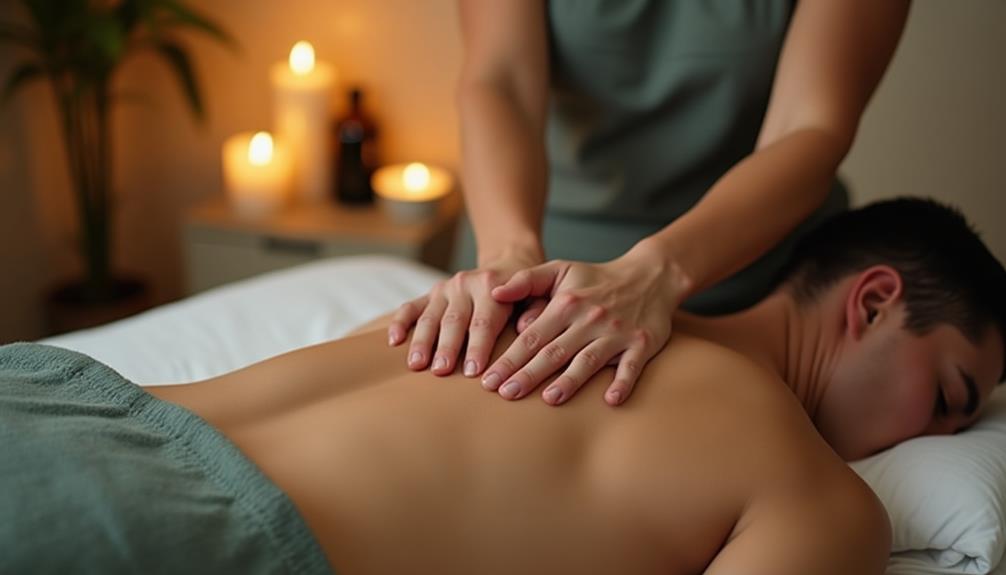To enhance your recovery as an athlete, focus on a few key practices. First, stay hydrated before, during, and after workouts. Second, prioritize nutrition by consuming protein and healthy fats within an hour after exercise. Quality sleep is crucial, so establish a routine for better rest. Incorporate active recovery techniques like light stretching or yoga to reduce soreness. Don't overlook mental aspects; visualization and deep breathing can alleviate stress. By mastering these practices, you'll optimize both your performance and recovery time, paving the way for greater success in your athletic pursuits. There's much more to explore on this topic!
Core Insights
- Prioritize hydration by drinking water before, during, and after workouts to maintain energy levels and performance.
- Focus on post-workout nutrition, consuming protein and healthy fats within 30-60 minutes to aid muscle repair.
- Ensure quality sleep by establishing a routine and creating a restful environment to enhance recovery and focus.
- Incorporate active recovery techniques like light aerobic activities, stretching, and foam rolling to reduce soreness and improve circulation.
- Utilize visualization and breathing exercises to manage stress, enhance relaxation, and support the mental aspect of recovery.
Importance of Recovery

Recovery is essential for athletes, playing an integral role in maximizing performance and preventing injuries. When you push your body to its limits, it needs time to heal and adapt. This process helps repair muscle fibers, replenish energy stores, and reduce fatigue. Without adequate recovery, you risk overtraining, which can lead to burnout or injury. Incorporating CBD bath salts into your recovery routine can provide additional benefits, such as soothing muscle soreness and promoting relaxation.
Incorporating recovery practices into your routine isn't just advantageous; it's necessary. Prioritize rest days, engage in active recovery, and listen to your body's signals. Techniques like stretching, foam rolling, and low-intensity exercises can enhance recovery. Remember, recovery isn't a sign of weakness; it's an essential component of your training. By giving your body the time it needs, you're setting yourself up for long-term success in your athletic journey.
Hydration Techniques

- Pre-Workout Hydration: Aim to drink at least 16-20 ounces of water or a sports drink 2-3 hours before your activity. This prepares your body for the demands ahead. For enhanced hydration, consider incorporating leading coconut water brands into your pre-workout routine, as they offer natural electrolytes and minerals.
- During Activity: Consume 7-10 ounces of fluid every 10-20 minutes while exercising. This keeps your energy levels up and helps maintain peak performance.
- Post-Workout Rehydration: After your workout, replenish lost fluids with 16-24 ounces of water or an electrolyte drink. This aids recovery and restores hydration levels.
Nutritional Strategies

Post-workout, focus on protein to repair and build muscle. Good sources include lean meats, dairy, and plant-based options like beans or tofu. For convenience, consider protein bars that provide 15-30g of protein per serving, which is ideal for muscle recovery and growth. Don't forget healthy fats; they support overall health and can aid in recovery.
Timing matters too. Aim to eat a balanced meal within 30-60 minutes after exercising. This helps replenish glycogen stores and kick-starts muscle recovery. Finally, stay mindful of portion sizes to match your individual energy needs.
Sleep and Recovery

Getting enough sleep is essential for athletes looking to enhance their performance and recovery. Quality sleep helps your body repair itself, boosts your immune system, and improves mental focus. Here are three key strategies to improve your sleep:
- Establish a Routine: Go to bed and wake up at the same time every day. Consistency helps regulate your body's internal clock.
- Create a Sleep-Friendly Environment: Keep your bedroom dark, cool, and quiet. Consider using blackout curtains or a white noise machine to minimize distractions.
- Limit Screen Time Before Bed: Reduce exposure to screens at least an hour before sleep. The blue light emitted from devices can interfere with melatonin production, making it harder to fall asleep.
Implementing these strategies can greatly enhance your recovery.
Active Recovery Methods

Active recovery methods are an essential part of any athlete's training regimen. These techniques help reduce muscle soreness and improve blood circulation, aiding your recovery process.
Start with light aerobic activities, like walking, cycling, or swimming. Aim for about 20 to 30 minutes at a low intensity. This keeps your body moving without straining it.
Next, consider incorporating foam rolling or gentle massage. These methods release tension in your muscles and promote relaxation.
You might also find yoga beneficial. It encourages mindful movement and can help clear your mind after intense training.
Stretching and Flexibility

Incorporating stretching into your recovery routine can greatly enhance your flexibility and overall performance. Stretching helps maintain your range of motion, reduces muscle tension, and can even alleviate soreness after workouts. Here are three key benefits of regular stretching:
- Improved Flexibility: Regular stretching increases the length of your muscles and tendons, allowing for better movement patterns.
- Injury Prevention: By enhancing flexibility, you can reduce the risk of strains and sprains during physical activity.
- Enhanced Recovery: Stretching promotes blood flow to the muscles, speeding up recovery and reducing muscle stiffness.
Integrating these practices into your post-workout routine will not only support your recovery but also contribute to your long-term athletic success.
Foam Rolling Benefits

Foam rolling offers athletes an effective way to enhance muscle recovery and reduce soreness. By applying pressure to specific muscle groups, you can release tension and improve blood flow. This process helps break up knots and fascia, which often leads to increased flexibility and range of motion.
To get started, choose a foam roller and identify tight areas in your body. Roll slowly over these spots, pausing briefly on particularly tender areas. Aim for 10-15 minutes per session, focusing on major muscle groups like your quads, hamstrings, and back.
Incorporating foam rolling into your routine can notably reduce recovery time and enhance overall performance. So, make it a habit and feel the difference in your training and recovery journey.
Massage Therapy

While foam rolling effectively targets muscle tension, massage therapy takes recovery a step further by offering a personalized approach to muscle care. This hands-on technique not only relieves tightness but also enhances circulation, promotes relaxation, and aids in injury prevention.
Here are three key benefits of incorporating massage therapy into your recovery routine:
- Improved Flexibility: Regular massages help loosen tight muscles and increase your range of motion.
- Reduced Muscle Soreness: Post-workout massages can minimize soreness and expedite recovery.
- Stress Relief: The calming nature of massage therapy lowers cortisol levels, helping you unwind mentally.
Cryotherapy Insights

Cryotherapy has gained popularity among athletes seeking rapid recovery and enhanced performance. This treatment involves exposing your body to extremely cold temperatures for a short period.
How It Works
When you enter a cryotherapy chamber, the cold constricts blood vessels and reduces inflammation. This process helps alleviate muscle soreness and speeds up recovery times.
Benefits
You might experience reduced pain and improved circulation after a session. Many athletes report feeling rejuvenated and ready to train again sooner.
Usage Tips
Consider scheduling cryotherapy sessions post-workout or during recovery days. It is crucial to consult with a healthcare professional before starting, especially if you have underlying health conditions.
Incorporating cryotherapy into your routine can be a game-changer for your recovery strategy.
Mindfulness and Mental Recovery

Incorporating mindfulness into your recovery routine can greatly enhance your mental resilience and focus. By dedicating time to mindfulness practices, you can improve your overall performance and well-being. Here are three effective ways to integrate mindfulness into your recovery:
- Meditation: Spend just 10 minutes each day focusing on your breath. This can help you clear your mind and reduce stress.
- Visualization: Picture yourself successfully executing your sport. This mental imagery not only boosts confidence but also prepares your mind for competition.
- Gratitude Journaling: Write down three things you're grateful for each day. This simple practice can shift your mindset and enhance your outlook.
Frequently Asked Questions
How Long Should Recovery Periods Last Between Intense Training Sessions?
Think of a racehorse—those powerful legs need rest to perform at their peak. For you, recovery periods between intense sessions should ideally last 24 to 72 hours, depending on intensity, to maximize performance and prevent injury.
What Role Do Supplements Play in an Athlete's Recovery?
Supplements can greatly enhance your recovery by providing key nutrients that support muscle repair and reduce inflammation. They help replenish energy stores and improve overall performance, making your training sessions more effective and beneficial.
Can Recovery Practices Differ for Various Sports?
Sure, recovery practices can differ like choosing between yoga and a wrestling match. You've got to take into account your sport's demands; a sprinter might need quick bursts of rest, while a marathoner focuses on endurance and hydration.
How Can Athletes Track Their Recovery Progress Effectively?
You can track your recovery progress effectively by keeping a daily journal, using apps to monitor sleep and nutrition, and regularly evaluating your physical and mental state. Consistency in tracking will help you identify patterns over time.
What Are the Signs of Overtraining in Athletes?
You might notice signs of overtraining like persistent fatigue, decreased performance, irritability, or disrupted sleep. If you're experiencing these symptoms, it's essential to reassess your training intensity and allow for proper recovery time.

